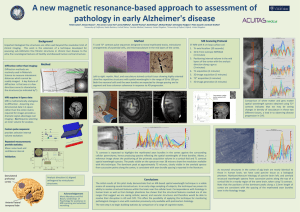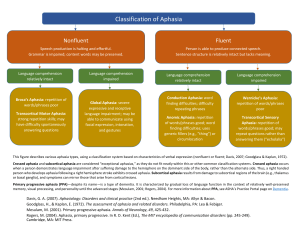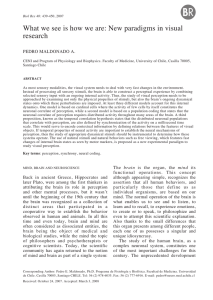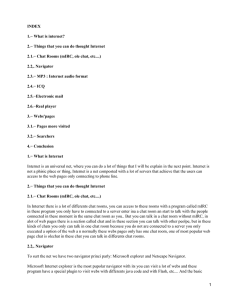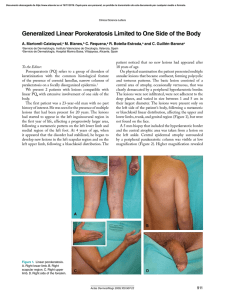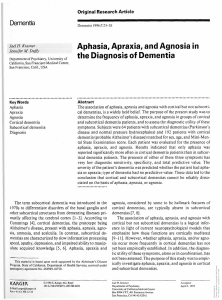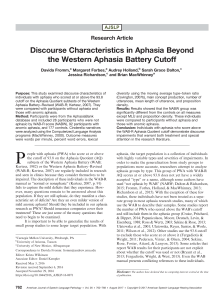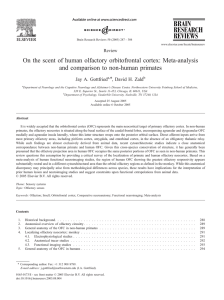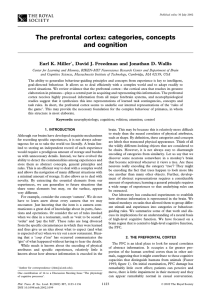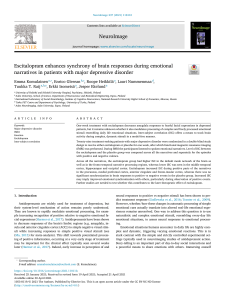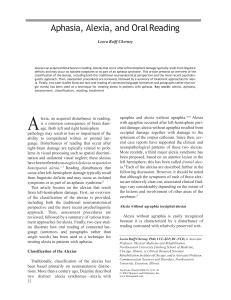Brain and Language:
Anuncio
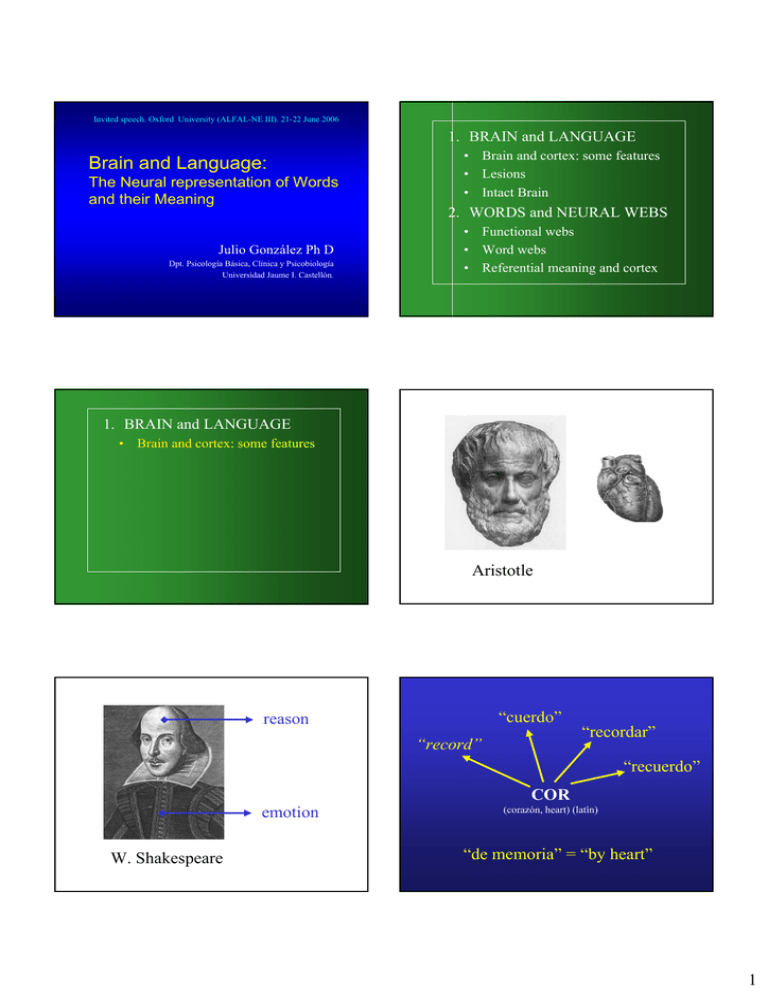
Invited speech. Oxford University (ALFAL-NE III). 21-22 June 2006 1. BRAIN and LANGUAGE Brain and Language: The Neural representation of Words and their Meaning Julio González Ph D Dpt. Psicología Básica, Clínica y Psicobiología Universidad Jaume I. Castellón. • Brain and cortex: some features • Lesions • Intact Brain 2. WORDS and NEURAL WEBS • Functional webs • Word webs • Referential meaning and cortex 1. BRAIN and LANGUAGE • Brain and cortex: some features Aristotle “cuerdo” reason “recordar” “record” “recuerdo” COR emotion W. Shakespeare (corazón, heart) (latín) “de memoria” = “by heart” 1 1011 = 100.000 million each one: 10.000 connections (synapses) neuron 1mm3 20.000 – 100.000 neurons • parallel • serial • distributed • local • parallel • serial • distributed • local • massive • nonmassive through: 4 km. axons 800.000.000 synapses (Abeles, 1991, 2004; Braitenberg & Shuez, 1998) Karl S. Lashley 2 motor somatosensorial Leg Hand Face visual auditory Primary areas: input, output (Brodmann, 1909; Pulvermüller, 2002) (Penfield & Rasmussen, 1950; Pulvermüller, 2002) 1. BRAIN and LANGUAGE • Brain and cortex: some features • Lesions 3 Language Laterality Paul Broca dominant cerebral hemisphere (left) • 1861: monsieur “Tan” Leborgne’s (Tan’s) brain Carl Wernicke 19 cases B Mouth 1874: case 4 Contemporary Examples (Strokes) W auditory Broca’s Aphasia blood supply to a part of the brain is interrupted Broca’s Aphasia Difficulty to say: P: ¿Cuántos años tienes? (43) [ Q: How old are you? (43) ] Broca’s Aphasia Q: ¿piso? (7) Q: ¿puerta? (14) [ Q: floor? door? ] “cuarenta y tres” No problem with individual motor gestures (lips, tongue, etc.) Broca’s Aphasia Difficulty to say: “siete” “catorce” Compensatory strategies: “ 1, 2, 3, 4, 5, 6, 7 ” 5 Broca’s Aphasia Broca’s Aphasia Naming task: (codo , muñeca) Comprehension?: Fairly good, but... [ elbow , wrist ] B difficulty with grammatically complex sentences: “¿cuanto hace que no vienes por aquí?” Mouth Wernicke’s Aphasia individual muscular groups: Ok. a more central damage This patient: L1: Valencian (Catalan) L2: Spanish speech scores 6 Wernicke’s Aphasia Wernicke’s Aphasia Very poor Comprehension: Very poor Comprehension: Toque un círcul Toque una fitxa groga [ Touch a circle ] [ Touch a yellow token ] Wernicke’s Aphasia Very poor Comprehension: P: On viu vosté? [Q: Where do you live? ] Wernicke’s Aphasia Diffficulty understanding: • language of others • own language (thought organization) Wernicke’s Aphasia Fluent speech but meaningless: • Paraphasias and Neologisms W • Intrusive material: “Jo soc Valencià” auditory [I am Valencian] 7 CLASSICAL LANGUAGE AREAS Perisylvian region Brain lesions: Valuable source of evidence Shortcomings: ¾ uncontrolled and unique (N=1) ¾ several subsystems and connections between remote areas can be damaged Sylvian fissure 1. BRAIN and LANGUAGE • Brain and cortex: some features • Lesions • Intact Brain good temporal resolution (ms): • EEG / ERP (event-related potentials) • MEG (magnetoencephalography) good spatial resolution (mm3): • PET (positron emission tomography) Intact Brain: Modern neurophysiological and Neuroimagen techniques 1. BRAIN and LANGUAGE • Brain and cortex: some features • Lesions • Intact Brain 2. WORDS and NEURAL WEBS • Functional webs • fMRI (functional magnetic resonance imaging) 8 Donald Hebb: Donald Hebb: “Any two cells or systems of cells that are repeatedly active at the same time will tend to become ‘associated’, so that activity in one facilitates activity in the other” (Hebb, 1949, p.70) correlation learning principle localizationists “cell assemblies” synchronously activated neurons should link into cell assemblies underlying cognitive processes The question whether cell assemblies exist in cortex has long been believed to be impossible to test by empirical research. However, more recent experimental work provided strong evidence for the Hebbian ideas. (Pulvermüller, 1999) holistic approach functional Web: functional Web a set of neurons that: two activity states: (1) are strongly connected to each other (2) are distributed over a specific set of cortical areas (3) work together as a functional unit ignition (full activation) (Braitemberg, 1978) reverberation (Abeles et al., 1991, 1992) (4) whose major parts are dependent of each other Pulvermüller (2003) 9 delay (16 s.) delay (16 s.) cell-firing records delayed match-to-sample (DMS) task Fuster (1997); Fuster & Jervey (1982) 1. BRAIN and LANGUAGE cooling • Brain and cortex: some features • Lesions • Intact Brain 2. WORDS and NEURAL WEBS 100 % 100 % % correct 50 % % correct • Functional webs • Word webs 50 % Word Webs: Words are processed by distributed neuronal webs with cortical topographies that reflect their meanings This rules out a unified “meaning center” Friedemann Pulvermüller Medical Research Council (MRC). Cambridge, UK 10 distributed cortex (meaning) bilateral Evidences of word webs perisylvian cortex (phonological form) lateral ERP (Event-related Potentials) MEG (Magnetoencephalography) Words Pseudowords MEG (magnetoencephalography) Finnish: “lakko” “vakko” kk Words: activity in the gamma band (>25 Hz) (strike) (........) /ko/ acoustic waveform (Eulitz et al., 2000; Krause et al., 1998; Pulvermüller, et al., 1996) 11 t n e sil a g n hi vie c t w a mo Mismatch negativities (MMNs) elicited by /ko/. Pulvermüller, Kujala, et al. (2001). brain response to a word: (full activation of a word web) ¾ early (200 ms) ¾ automatic (attention is not necessary) Referential meaning and cortex: Word use in the context of objects and actions leads to associations between neurons in the language areas and additional neurons in areas processing information about the word’s referents Mismatch negativities (MMNs) elicited by /ko/. Pulvermüller, Kujala, et al. (2001). 1. BRAIN and LANGUAGE • Brain and cortex: some features • Lesions • Intact Brain 2. WORDS and NEURAL WEBS • Functional webs • Word webs • Referential meaning and cortex Referential meaning and cortex: additional neurons in areas processing information about the word’s referents Pulvermüller (2003) their cortical distribution is determined by the referent 12 Visually related words Action related words “hammer” “shark” other animals “fork” “whale” tool names / verbs COLOR NAMES Visually related words Action related words “green” “red” “blue” ...... PET Martin, Wiggs, et al., (1996); Pulvermüller, Lutzenberger, et al., (1999). Martin, Haxby, et al., Science (1995). Neuropsychological patient studies: more fine-grained predictions: Nouns and verbs, animal and tool names are differentially affected by brain damage. Action verbs (body parts) (Damasio & Tranel, 1993; Daniele et al., 1994; Humphreys & Borde, 2001; Miceli et al., 1984, 1988; Warrington & McCarthy, 1983; Warrington & Shallice, 1984; etc.) 13 to walk to pick to kiss to kick to applaud to bite to run to comb to blow to jump to grab to chew to wander .......... to draw .......... to yawn .......... to pick passive reading task Hauk, Johnsrude, & Pulvermüller, 2004 Hauk, Johnsrude, & Pulvermüller, 2004 functional Magnetic Resonance Imaging (fMRI) experimental task rest or baseline functional Magnetic Resonance Imaging (fMRI) leg Movements Words hand face to kick = chutar Pulvermüller, Nature Reviews Neuroscience (2005). to pick = coger to kiss = besar Pulvermüller, Nature Reviews Neuroscience (2005). 14 130 ms Information about the body parts with which actions are being carried out may be woven into the word-related cortical networks. spoken stimulus: 140 ms leg-related verb 150 ms 160 ms 170 ms magnetoencephalography Words are represented and processed by functional webs in which information about a word’s form and that about its semantics are interwoven. 180 ms 190 ms Pulvermüller, Shtyrov & Ilmoniemi (2005). 200 ms 210 ms rating words according to their olfactory associations 18 people “Olfactory” words odour-related words 1 Universidad Jaume I. Castellón (Spain) 60 olfactory words • • • • • • • ajo (garlic) canela (cinnamon) cloaca (sewer) flor (flower) colonia (cologne) sobaco (armpit) …….. 60 control words • • • • • • • nube (cloud) gafas (glasses) pinza (hairgrip) aguja (needle) tambor (drum) letra (letter) …….. • • • • • • • 2 4 5 6 7 no or very weak associations very strong associations 60 olfactory words 60 control words ajo (garlic) canela (cinnamon) cloaca (sewer) flor (flower) colonia (cologne) sobaco (armpit) ..... mean rate (1-7) = 6.0 mean rate (1-7) = 6.0 3 • • • • • • • nube (cloud) gafas (glasses) pinza (hairgrip) aguja (needle) tambor (drum) letra (letter) ...... mean rate (1-7) = 1.2 mean rate (1-7) = 1.2 15 ajo passive reading task 750 milliseconds Odour processing: main pathways sla e t .5 to 1 ESA) van stellón (ER A ens neral Ca m Sie tal Ge spi Ho 23 participants orbitofrontal cortex piriform cortex amygdala Our results suggest that reading odour-related words elicits activation of olfactory brain regions Z = -18 Z = -16 This fact is compatible with a theoretical framework according to which words are processed by distributed cortical systems involving information about the referential meaning. Brain activation reading olfactory words (minus control words) González, Barros, PulverMüller, et al., (2006). 16 Further Research: • to determine the point in time when olfactory activation arises, and whether this activation occurs automatically and immediately as part of the semantic processing. • role of the hedonic valence (pleasant vs unpleasant odour). CONCLUSION: Data suggest that word meaning is not confined to just meaning-specific brain regions; rather, it seems likely that semantic representations are distributed in a systematic way throughout the entire brain. END Pulvermüller (1999) 17
